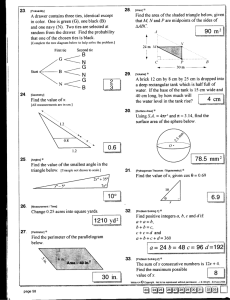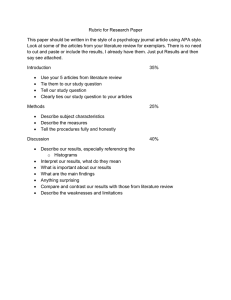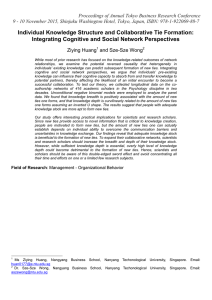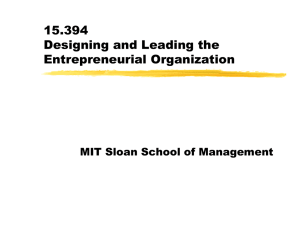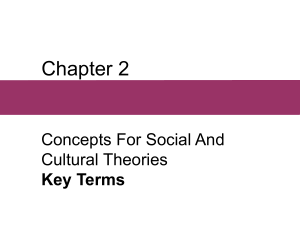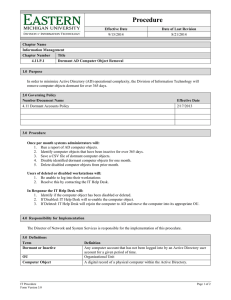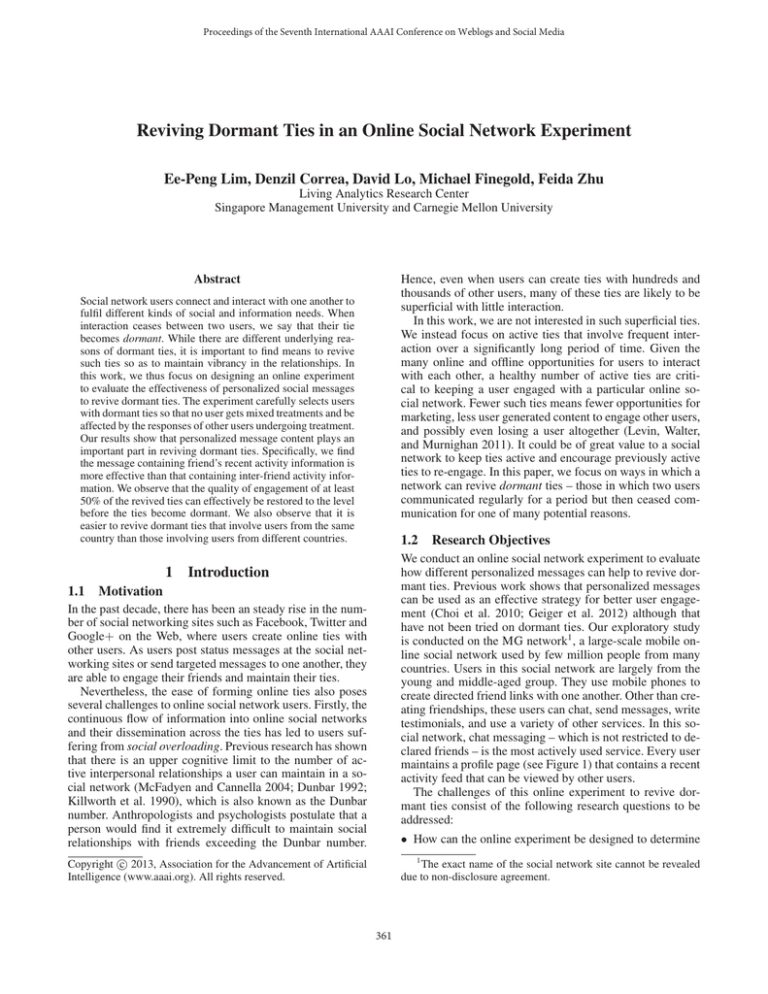
Proceedings of the Seventh International AAAI Conference on Weblogs and Social Media
Reviving Dormant Ties in an Online Social Network Experiment
Ee-Peng Lim, Denzil Correa, David Lo, Michael Finegold, Feida Zhu
Living Analytics Research Center
Singapore Management University and Carnegie Mellon University
Hence, even when users can create ties with hundreds and
thousands of other users, many of these ties are likely to be
superficial with little interaction.
In this work, we are not interested in such superficial ties.
We instead focus on active ties that involve frequent interaction over a significantly long period of time. Given the
many online and offline opportunities for users to interact
with each other, a healthy number of active ties are critical to keeping a user engaged with a particular online social network. Fewer such ties means fewer opportunities for
marketing, less user generated content to engage other users,
and possibly even losing a user altogether (Levin, Walter,
and Murnighan 2011). It could be of great value to a social
network to keep ties active and encourage previously active
ties to re-engage. In this paper, we focus on ways in which a
network can revive dormant ties – those in which two users
communicated regularly for a period but then ceased communication for one of many potential reasons.
Abstract
Social network users connect and interact with one another to
fulfil different kinds of social and information needs. When
interaction ceases between two users, we say that their tie
becomes dormant. While there are different underlying reasons of dormant ties, it is important to find means to revive
such ties so as to maintain vibrancy in the relationships. In
this work, we thus focus on designing an online experiment
to evaluate the effectiveness of personalized social messages
to revive dormant ties. The experiment carefully selects users
with dormant ties so that no user gets mixed treatments and be
affected by the responses of other users undergoing treatment.
Our results show that personalized message content plays an
important part in reviving dormant ties. Specifically, we find
the message containing friend’s recent activity information is
more effective than that containing inter-friend activity information. We observe that the quality of engagement of at least
50% of the revived ties can effectively be restored to the level
before the ties become dormant. We also observe that it is
easier to revive dormant ties that involve users from the same
country than those involving users from different countries.
1
1.1
1.2
Research Objectives
We conduct an online social network experiment to evaluate
how different personalized messages can help to revive dormant ties. Previous work shows that personalized messages
can be used as an effective strategy for better user engagement (Choi et al. 2010; Geiger et al. 2012) although that
have not been tried on dormant ties. Our exploratory study
is conducted on the MG network1 , a large-scale mobile online social network used by few million people from many
countries. Users in this social network are largely from the
young and middle-aged group. They use mobile phones to
create directed friend links with one another. Other than creating friendships, these users can chat, send messages, write
testimonials, and use a variety of other services. In this social network, chat messaging – which is not restricted to declared friends – is the most actively used service. Every user
maintains a profile page (see Figure 1) that contains a recent
activity feed that can be viewed by other users.
The challenges of this online experiment to revive dormant ties consist of the following research questions to be
addressed:
Introduction
Motivation
In the past decade, there has been an steady rise in the number of social networking sites such as Facebook, Twitter and
Google+ on the Web, where users create online ties with
other users. As users post status messages at the social networking sites or send targeted messages to one another, they
are able to engage their friends and maintain their ties.
Nevertheless, the ease of forming online ties also poses
several challenges to online social network users. Firstly, the
continuous flow of information into online social networks
and their dissemination across the ties has led to users suffering from social overloading. Previous research has shown
that there is an upper cognitive limit to the number of active interpersonal relationships a user can maintain in a social network (McFadyen and Cannella 2004; Dunbar 1992;
Killworth et al. 1990), which is also known as the Dunbar
number. Anthropologists and psychologists postulate that a
person would find it extremely difficult to maintain social
relationships with friends exceeding the Dunbar number.
• How can the online experiment be designed to determine
c 2013, Association for the Advancement of Artificial
Copyright Intelligence (www.aaai.org). All rights reserved.
1
The exact name of the social network site cannot be revealed
due to non-disclosure agreement.
361
mant ties and a URL shortening service to collect user responses to the messages. These are useful software modules which serve as the core components of our online social network experiment. With them, our experiment does
not require any existing service of the MG network to be
modified.
the effectiveness of personalized messages while avoiding
undesirable network effects that may affect the validity of
the experiment results?
• How can the personalized messages be crafted and what
are factors are to be considered in the message content?
The content should not be fictitious as users can easily
verify the message content. At the same time, we want
the content to create the appropriate desire for the users to
revive their dormant ties.
• Our experiment shows that personalized message containing an account of a friend’s activity can revive dormant
ties and is more effective than personalized message containing inter-friend activity information. We measure the
effectiveness by the fraction of dormant ties that achieve
a minimum level of re-engagement and the level of reengagement of revived ties.
• How can the personalized messages be delivered such that
the users do not find these messages intrusive? The messages should also minimize disruptions to the online social network business, a key concern expressed by our collaborating company.
1.3
• What are the measurable variables to determine the success of dormant tie revival? How are the relevant data collected throughout the experiment?
Paper Outline
We organize the rest of the paper as follows. Related work
is covered in Section 2. We give our definition of dormant
tie in Section 3 and a description of our experiment design
in Section 4. The results of our experiment are analyzed in
Section 5.
2
Related Work
The research on dormant ties and their revival is at the
nascent stage. Quinn studied the reconnection of dormant
social ties for midlife adults using email, social network
sites and search engines (Quinn 2013). In their work, a
small group of 23 participants were interviewed and their
responses were analyzed. The key findings include: (a) context of the lost social contacts is useful for the latter to be
located and reconnected; (b) internet communication allows
the temporal identity of individuals to be compressed and
examined by their lost contacts; and (c) reconnection of dormant ties may not be actively pursued as individuals find it
satisfying enough to passively engage their lost contacts by
reading their online profiles.
Unlike the above work, our research focuses on reviving
online social ties which are dormant for short duration instead of creating new ties with long lost friends. To help
users uncover the latter, several online social network sites
such as Facebook and LinkedIn have implemented a variety of friend recommendation services making use of user
profile attributes (e.g., high school/university attended, age,
etc.) as well as already known common friends between
users to suggest new friends to be added to the online friend
lists. A summary of the link prediction methods that can
be used for friend recommendation can be found in (LibenNowell and Kleinberg 2007; Aiello et al. 2012).
Quercia et al. analyzed Facebook friendships and concluded that a friendship is more likely to become dormant
(or broken) if the users are not embedded in the same social
circle, the users have considerable age difference, and one
of them is a neurotic or introvert (Quercia, Bodaghi, and
Crowcroft 2012). Their work however does not introduce
nor experiment any means to revive the dormant ties. Dormant ties can be a cause of user churns. There are several
previous works on churn analysis and prediction in online
social networks (Karnstedt et al. 2011; Oentaryo et al. 2012)
Figure 1: User Profile Page
This paper addresses the above challenges with a detailed
design and implementation of an online social network experiment. The contributions in the paper are as follows.
• To the best of our knowledge, this work is the first experimental study on reviving dormant ties in an online social
network. The experiment involves identifying and dividing the dormant ties into treatment and control groups so
as to evaluate the responses from real users when given
different treatments of personalized messages. The experiment is also designed to minimize interference between
treatments which often happens in a network setting.
• The use of personalized messages as a social tactic to revive dormant ties is novel. We design two types of personalized message, one containing recent activity information, and another containing recent inter-friend activity
information. The information contained in the messages
are generated from historical user data. We also embed the
URL of the friend in the message to facilitate checking of
the friend’s online profile as well as sending messages.
• To conduct this experiment, we develop an automated
agent to send personalized messages to the selected dor-
362
criteria, we are left with 1973 consistently active users. We
denote this set of users as Ua (|Ua | = 1973).
but none of them attempts to prevent churns by reducing dormant ties of likely-to-churn users.
Recently, Tian et al. studied the problem of maintaining active interactions among users who are already connected by online social links (Tian et al. 2010). They proposed a tie revival method to recommend friends to interact with so as to maximize the interaction connectivity
among users. The proposed method has been evaluated on
a large scale cellphone call network and the Facebook network without involving real users. Similarly, to improve information dissemination among users, Papagelis et al. proposed a heuristic-sampling based method to add ghost ties
to a social network so as to reduce the average shortest-path
distance between pairs of users (Papagelis, Bonchi, and Gionis 2011). Both the above works however do not include the
design of recommendation mechanisms for the users to perform new interactions or to add new links. They also do not
evaluate the effectiveness of their methods on real users.
Our work is unique in that it conducts a carefully designed online experiment with real users. Instead of optimizing some objective function defined based on simple assumptions about user behavior in making friends and interactions, we evaluate the effectiveness of personalized messages on reviving dormant ties of real users. Our focus is
therefore on the study of factors that affect the effectiveness
of messages and on the development of a principled way to
evaluate the tie revival outcomes.
3
3.2
• Ed = {(ui , uj )|ui , uj ∈ Ua ∧
(ui , uj ) is dormant in August 2012.}
• Ud = {uk |(uk , uj ) ∈ Ed ∨ (ui , uk ) ∈ Ed }
Among the 1973 active users, we found 1691 of them
having at least one dormant tie in Gd . This shows that dormant ties are common even among active users. There are
5128 dormant ties in Gd which are potentially the targets
for our message treatments. The average degree (i.e., number of dormant ties) of users in Gd is around 6. Gd therefore consists of a large connected component of 1681 active
users, and other 4 small connected components with sizes
not larger than 3. Since many users are involved in multiple dormant ties, we cannot treat all the ties while avoiding
significant network effects that complicate the experiment
results. We attempt to avoid this problem by requiring each
user to be involved in at most one connection designated for
one of the treatment or control groups.
Dormant Ties in Social Networks
Dormant ties are not a new issue for social network sites, but
there is no commonly adopted definition. In this section, we
describe the MG network and give our definition of dormant
ties.
3.1
Dormant Tie Detection
We are interested in ties that turn inactive after some months
of staying active. As a churn user is one who does not chat
at all over 30 consecutive days, we empirically define an inactive tie to be one without any two-way chat messages over
30 consecutive days in a month. An active tie is defined to
be one where each user sends the other at least one message
every month. In our experiment, we therefore define a dormant tie to be: (a) a tie active during the January to July 2012
period; and (b) inactive for the entire month of August 2012.
We construct the relevant dormant graph, Gd = Ud , Ed where:
4
Mobile Social Network Dataset and Active
Users
Experiment Design
In this randomized controlled experiment research, we aim
to answer the following research questions:
Through collaborating with the operator of MG, we have
gained access to the user profile data including country affiliations, gender, age and preferred language, as well as user
message statistics including number of messages posted,
message recipients, dates and times. These data are collected
on a monthly basis beginning from January 2012 to December 2012. At the beginning of each month, we receive the
previous month’s profile and activity data. Our online experiment with the real MG users was conducted in October
2012.
We first identify a set of active users who could participate
in our experiments should their active ties become dormant.
We define an active user to be one who contributes at least
30 messages in each of the months from January to August
2012. The August 2012 data was the latest we had during the
time active users were determined. The 30 message threshold is equivalent to sending on average one message per day
over a month. Such active users will be eligible to get our
treatment, and will also have sufficient propensity to send
messages in response to our treatment to revive dormant ties
within a month’s time. After applying the above active user
• Q1: Are personalized messages effective in reviving dormant ties? If so, what type of messages will be more effective?
• Q2: Do user attributes affect the success rate of dormant
tie revival? In this experiment, we would like to study the
role of gender and country attributes of users in reviving
ties.
To answer question Q1, we design different types of personalized messages as described in Section 4.2. Q2 can be
addressed by considering a randomized block design in our
experiment with blocks of dormant ties defined by different
user attribute combinations. Both the two dormant tie selection and randomized block design will be covered in Section 4.1. We finally describe the experiment mechanisms to
send users messages and track the dependent variables.
Overview of Experiment. Figure 2 depicts the overall
experiment design. The active user selection and dormant
tie detection are first performed using the January to August
2012 data as described in Section 3. We further restrict the
subset of dormant ties to ensure each user is represented at
363
4.1
Log(# dormant ties)
most once and then divide the remaining ties into treatment
groups and control groups to be described in Section 4.1.
Each treatment group of dormant ties is given personalized
messages of the same type to be given in Section 4.2. These
messages will be sent to the users involved using an automated agent. To track users clicking on URLs embedded in
the messages, we also deploy a URL shortening service. Finally, the results of experiment are analyzed.
Independent Dormant Ties Selection
In Section 3.2, we determine a set of dormant ties in the dormant graph Gd = Ud , Ed . Randomly assigning these ties
to treatment and control groups would result in the same user
appearing in multiple treatment groups or appearing multiple times in the same treatment group. This could introduce
a number of complications.
Therefore, we select only those dormant ties from Gd
such that they share no common users. We use a simple iterative removal strategy to find an independent dormant tie
set. The strategy randomly selects one dormant tie (ui , uj )
for each iteration and remove the dormant ties connected to
ui or uj . In the next iteration, another dormant tie is selected
and its connected dormant ties are removed. We repeat the
step until all dormant ties in Gd are examined.
Log(# msgs between users)
Figure 4: Message Distribution of Dormant Ties in July
tie will be revived subsequently. The message has to be personalized as we need to make the users aware of the specific
target dormant tie to be revived. As it is unclear which of the
two users will receive and act upon the personalized message, we decided to send both users the messages with the
content appropriately crafted.
MG supports both online and offline message exchanges
between users. The online messages are similar to real-time
chat messages which may involve two or more online users
in an interactive chat session. An offline message can be
sent when the recipient is offline and the message received
is stored in the recipient’s inbox. Offline messages involve
only two users, i.e., sender and recipient. Both online and
offline messages cannot exceed 255 characters while most
of them are shorter than 160 characters. To make the personalized messages easy to read on mobile devices, we decide
to keep them no longer than 160 characters.
Previous research in recommender systems has shown
that users prefer more detailed information on their recommendation rather than just a plain recommendation
(Swearingen and Sinha 2002). Generally, we can treat users
with social or informational messages depending on the information contained in the messages. A social message contains some knowledge about friends while an information
message contains population or community level knowledge. Bond et. al, have shown that social messages may be
more effective than informational messages in mobilizing
users to declare their political self-expression and to seek
information (Bond et al. 2012). We therefore focus on designing social messages to our users with dormant ties.
Two kinds of social messages have been crafted in our
experiment as follows:
Figure 3: Independent Dormant Tie Selection
Figure 3 depicts a simple dormant graph with (u1 , u2 ) and
(u3 , u4 ) selected as independent dormant ties. The other two
dormant ties are not selected due to the already selected u1
and u2 in the first step. After applying independent dormant
tie selection on the dormant graph Gd obtained earlier, we
are left with 1338 active users and 669 dormant ties that can
be used in our experiment. As users in three of the dormant
ties do not carry gender and country attribute information,
we exclude them and keep a final set of 1332 users and
their 666 dormant ties. Recall that the users of the 666 dormant ties are active (i.e., have sent at least 30 messages each
month between January 2012 to August 2012) and the dormant ties are pairs of users interacting in July 2012 but not in
August 2012. Figure 4 depicts the scatterplot of number of
messages exchanged between users of each dormant tie. It
shows that there could be as many as 705 messages between
two users of a tie in July before it becomes dormant in August. Most of the dormant ties have less than 10 messages in
July.
4.2
• Social message containing friend’s activity information
(M1): The information content of this type of message
consists of messaging activity statistics of the friend involved in a dormant tie as shown in Table 12 . The intuition
is that a user may interact with another user if the former
Treatment of Dormant Ties
2
The message to u2 is similar except that u1 ’s information is
now given.
Given a dormant tie involving two users, we send personalized messages to the two users involved to examine if their
364
Active User
Selection
Jan to Aug
Social
Network
Data
Dormant Tie
Detection
Independent
Dormant Tie
Selection/
Randomization
Treatment
Group 1
Messaging
Agent
Treatment
Group 2
Control
Group
MG Social Network
URL Shortening
Service
Result Analysis
Sep to Dec
Social
Network
Data
Figure 2: Experiment Design
is aware that the latter is active on the network.
Table 2: Randomized Assignment of Dormant Ties
XX
XXX Block B1 B2 B3 B4
# Ties
XX
Group
X
• Social message containing inter-friend activity information (M2): The information content of this type of message consists of interaction statistics between mutual
friends (see Table 1) of the two users sharing a dormant
link, say u1 and u2 . The intuition is that if we inform
both u1 and u2 that each is interacting with some mutual
friends of u1 and u2 , this will arouse some curiosity in u1
and u2 to find out more about each other, thus reviving
their shared tie.
TGroup1
44
105 20
54
TGroup2
44
105 20
54
CntGroup
42
104 20
54
Subtotal
130 314 60 162
B1: (same country, same gender)
B2: (same country, different gender)
B3: (different country, same gender)
B4: (different country, different gender)
In Table 1, both the message templates contain a URL,
i.e., U RL(u2 ), to allow the treated user u1 to click so as to
quickly view u2 ’s profile page and to send a message to u2
if so decided by u1 .
We use a randomized block design to assign treatments to
ties. We create four blocks of ties described in Table 2 based
on the similarity of gender and country of the two users.
We then randomly assign three treatments within each of the
four blocks:
The timing of the messages means that it is possible some
ties classified as dormant could become active prior to the
message being received. Since treatments were assigned randomly this was as likely to happen in either of the three treatment or control groups and has no impact on the statistical
analysis of the experiment. In fact, only 38 of the dormant
ties had activity in this period and they are excluded from
our subsequent analysis.
Not every user of treated dormant ties received our messages. This is attributed to privacy settings of several users
that prevent messages from reaching them. We tabulate (a)
the number of dormant ties with only one user receiving our
personalized message (denoted by Reach-One); and (b) the
number of dormant ties with both users receiving the message (denoted by Reach-Both) as shown in Table 3. Note that
there are some cases our personalized messages could not
reach both users of dormant ties. For example, our messages
were not able reach any users of 28 (13%) and 33 (15%)
dormant ties in TGroup1 and TGroup2 respectively.
Considering only the reachable dormant ties, we revise
Table 2 and obtain the reachable dormant tie distribution
shown in Table 4. We restrict our analysis to those ties able
to receive at least one message (including identifying the
same subset of the control group). Since users with different privacy settings may behave differently, we can extend
any conclusions to the entire population. Since the same restrictions applied to the control group, however, we can still
measure the impact of personalized messages on those we
• Treatment group I (TGroup1): Users of dormant ties in
this group are treated with type M1 messages;
• Treatment group II (TGroup2): Users of dormant ties in
this group are treated with type M2 messages; and
• Control group (CntGroup): Users of dormant ties in this
group are not given any messages.
The control group receives no message so that we can measure the impact of the network operator’s interaction. There
is no systematic difference between treatment and control
other than the personalized messages sent by the network
operator.
4.3
223
223
220
666
Online Evaluation of Message Treatment
MG maintains several official user accounts to interact with
her users providing both technical and administrative support. In our experiment, we created another official user account and operated the account using an automated agent.
The agent is programmed to inject appropriate personalized
messages to both the users involved in dormant ties. The
personalized messages were sent out on 10 October 2012.
365
Message Type
M1 (with friend’s activity info.)
M2 (with inter-friend activity info.)
Table 1: Message Table
Message Template to u1
Your friend u2 has sent x messages. Check it out U RL(u2 )
u3 and y other of your friends have exchanged x messages with your friend u2 .
Check it out U RL(u2 )
2011). The specific time duration varies from domain to domain. In our experiment, we send the same personalized
messages to the treated users again if they have not clicked
our URLs in 14 days (i.e., October 24, 2012). When a user
actually sends a message to his friend in a dormant tie with
him in the month of October 2012, we will be able to detect
this using the user data supplied to us at the beginning of
November 2012.
Table 3: Statistics of Message Reach: Reach-One = Reach
One of the Users in the Tie; Reach-Both = Reach Both Users
in the Tie; # Treated Ties = Number of Ties where Personalized Messages are Sent; Max # Clicks = Maximum Number
of Reached Users that Potentially Click the URL in the Personalized Message.
Group
TGroup1
TGroup2
Reach-One
87 (39%)
79 (35%)
Reach-Both
108 (48%)
111 (50%)
# Treated Ties
223 (100%)
223 (100%)
Max # Clicks
302
301
5 Experiment Results
5.1
are able to reach.
Hypothesis tests. We first set up the following hypotheses
to evaluate the effectiveness of personalized messages M1
and M2. The effectiveness can be measured by the amount
of passive engagement and active engagement. The former
can be accounted by number of clicks while the latter can
be accounted by number of revived ties. We define a revived
tie to be a dormant tie with at least one message between its
users between 10 October 2012 and 31 October 2012. While
one message alone does not imply a serious revival of activity, it is the necessary first step – and our experiment measures whether the network operator can instigate that first
step with a simple message.
For passive engagement, only users in TGroup1 and
TGroup2 are given personalized M1 and M2 messages respectively. We therefore compare the amount of passive engagement for TGroup1 and TGroup2 only. For active engagement, we evaluate the effectiveness of M1 and M2 messages on users from TGroup1/TGroup2 groups versus those
from control group. Our null hypotheses include:
Dormant Tie Distribution
XXTable 4: Reachable
XXX Block B1 B2 B3 B4
# Ties
XXX
Group
TGroup1
42
88
22
43
TGroup2
39
85
21
45
CntGroup
40
92
14
50
Subtotal
121 265 57 138
B1: (same country, same gender)
B2: (same country, different gender)
B3: (different country, same gender)
B4: (different country, different gender)
Effectiveness of Personalized Messages
195
190
196
581
There are two dependent variables we use to track two
kinds of responses from the users, namely (a) Passive engagement: this is measured by clicks on the URL embedded
in the personalized messages (for TGroup1 and TGroup2),
(b) Active engagement: this is measured by the number
of messages between users of dormant ties (for TGroup1,
TGroup2 and CntGroup).
By clicking on the URL (say, U RL(uj )) embedded in a
message, a user will get to see the profile page of the other
user (e.g., uj ) of the treated dormant tie. This is also known
as the passive engagement as it does not involve any real
communication (Marlow et al. 2009).
We track URL clicks by creating a URL shortening service such that each shortened URL encodes the identity of
the user who originally received a personalized message
from our automated agent. Hence, whenever a user clicks
on the URL, her identity will be recorded and the URL of
her friend’s profile page is returned. Depending on whether
a single user or both users of treated dormant ties receive
our personalized messages, we can determine the maximum
number of clicks of TGroup1 and TGroup2 by (1×#ReachOne)+(2×#Reach-Both) as shown in Table 3. We collected
the click data from till the end of August.
Learning science theory says that the recall of humans
deteriorates after a certain time duration (Clark and Mayer
• Null Hypothesis A (HA0 ): There is no difference in the
number of clicks (passive engagement) between users receiving M1 messages (i.e., TGroup1) and users receiving
M2 message group (i.e., TGroup2).
• Null Hypothesis B (HB0 ): There is no difference in number of revived ties (active engagement) between users receiving M1 messages (i.e., TGroup1) and users in control
group.
• Null Hypothesis C (HC0 ): There is no difference in the
number of revived ties (active engagement) between users
receiving M2 messages (i.e., TGroup2) and and users in
control group.
We conduct two-tailed Fisher’s Exact Tests on our collected data using two contingency tables as shown in Tables 5, and 6. The resulting p-values are: (a) 0.033 for null
hypothesis HA0 ; (b) 0.0044 for null hypothesis HB0 ; and (c)
1.0 for null hypothesis HC0 .
There is moderate evidence that personalized messages
of type M1 are more effective in getting users of dormant
366
XXX
Outcome
XX
XXX # Click
Group
TGroup1
147
TGroup2
120
treatment engagement quality is > 1.0, we say that the engagement quality is restored beyond the the expected quality.
Analysis of early effect. The early post-treatment engagement quality is derived between October 10 and the end
of October, a period shorter than a month, the normalized
early post-treatment engagement quality is expected to be
around 23 if it is restored to the level before the revived ties
became dormant. Figure 5 depicts the early effect of personalized messages using boxplot that shows in log-scale the
maximum, upper quartile, median, lower quartile, and minimum normalized engagement quality for the revived ties.
Only the median values are shown in the figure. The figure
shows that the post-treatment engagement quality values are
mostly less than 1 suggesting that we are not able to restore
the quality of engagement even for TGroup1. We however
notice that revived ties in TGroup1 has shown better quality
than those in TGroup2 and CntGroup. A few revived ties in
TGroup1 manage to enjoy much higher than expected quality (e.g., 5 times the pre-treatment engagement quality). Interestingly, the revived ties in CntGroup show slightly better
post-treatment engagement quality than those in TGroup2.
This again could be due to M2 messages containing interfriend activity information which actually turn users away
from active engagement, but there is little evidence that the
message has any effect whatsoever.
# No-Clicks
155
181
Table 5: TGroup1 versus TGroup2 by number of clicks
XXX Outcome
XX
XXX # Revived Ties
Group
TGroup1
TGroup2
CntGroup
66
39
40
# Non-revived Ties
131
151
156
Table 6: TGroup1 and TGroup2 versus CntGroup by number
of revived ties
ties to passively engage their friends than personalized messages of type M2. There is stronger evidence that personalized messages of type M1 are more effective in actively
engaging their friends by sending them messages. There is
no evidence that personalized messages of type M2 have any
effect on reviving ties. While the test results are consistent
with one another, it is intriguing to see that type M2 messages do not lead to the same outcome as type M1 messages.
We could not contact the users directly to solicit feedback,
but a possible explanation is that users may feel that it is
not necessary to contact someone which is already engaged
in some active interaction with their other friends given that
most ties in the network are weak.
5.2
10
Quality of Engagement for Revived Ties
Hypothesis tests B and C only consider revived ties defined
by at least one message sent between users of dormant ties.
They however do not consider the quality of active engagement among users after their ties are revived. Ideally, we
would like to restore the engagement to the quality level
prior to the time the ties became dormant.
In this part of our experiment, we use:
1
0.46
0.19
0.10
0.2
0.18
0.05
0.1
1. the average number of messages per month between two
users in a dormant tie during the months of May to July
2012 as the pre-dormant engagement quality,
0.01
TGroup1
TGroup2
CntGroup
2. the number of messages between the two users in October after treatment as the early post-treatment engagement
quality, and
Figure 5: Normalized early post-treatment engagement quality
3. the average number of messages between the two users in
November and December 2012 as the late post-treatment
engagement quality.
Analysis of late effect. We now turn to Figure 6 that depicts the late effect of personalized messages. Among the
three revived ties groups, TGroup1 still yields the best engagement quality with median equal to one. This suggests
that at least half the revived ties have restored or even outperformed their pre-dormant engagement quality. Revived (or
more accurately the Still-Alive) ties in CntGroup has poorer
quality than those in TGroup1 suggesting that without any
treatment, the overall engagement quality of ties deteriorates compared with their pre-dormant engagement quality.
Again, we notice that TGroup2 gives the worst quality. This
strengthens the argument that M2 personalized message has
a negative effect on restoring engagement quality.
As users of different ties may exchange different number
of messages as part of their normal communication, we cannot apply the some threshold to determine if the quality of
engagement has been restored. We instead perform normalization on early and late post-treatment engagement qualities, i.e., items (2) and (3), dividing them by pre-dormant
engagement quality. The normalized post-treatment engagement quality is 1.0 if it has been fully restored. If the normalized post-treatment engagement quality is < 1.0, the engagement quality is not fully restored. If the normalized post-
367
10
10
1.02
1
1
0.5
0.63
0.31
0.21
0.1
0.1
0.01
0.01
TGroup1
TGroup2
same country
CntGroup
different countries
Figure 6: Normalized late post-treatment engagement quality
Figure 7: Normalized early post-treatment engagement quality for TGroup1
5.3
ter treatment than ties involving users with the same gender
(median = 0.46).
Other Observations
Country factor in dormant tie revival. We also investigate
how the user factor blocks may affect the effectiveness of
personalized message in reviving dormant ties. We first examine if it is easier to revive dormant ties involving users
from the same country for ties in treatment group TGroup1.
Table 7 show the distribution of revived/non-revived ties for
dormant ties involving users from same countries and from
different countries. The numbers in parentheses are the expected number of revived/non-revived ties. There is weak
evidence that it is easier to revive ties for dormant ties involving users from the same countries – we have a two-tailed
p value of 0.0505 when applying Fisher’s Exact Test.
XXX Outcome # Revived
XX
Ties
XXX
Group
TGroup1 (same )
country)
TGroup1 (different
country)
Total
# Non-revived
Ties
Total
51 (45)
98 (104)
149
13 (19)
51 (45)
64
64
149
213
XXX
Outcome # Revived
XX
Ties
XXX
Group
TGroup1 (same )
19 (22)
gender)
TGroup1 (different
47 (44)
gender)
Total
66
# Non-revived
Ties
Total
45 (42)
64
84 (87)
131
129
195
Table 8: Same Gender vs Different Gender by number of
revived ties
100
10
1
0.46
Table 7: Same Country vs Different Countries by number of
revived ties
0.5
0.1
Figure 7 depicts the normalized early post-treatment engagement quality for revived ties in TGroup1. It shows that
the revived ties involving users from the same country enjoy
slightly better quality of engagement (with median = 0.5)
than those from different countries (with median = 0.31).
Gender factor in dormant tie revival. We next examine if it is easier to revive dormant ties in treatment group
TGroup1 involving users with the same/different gender. Table 8 show the distribution of revived/non-revived ties for
dormant ties involving users with the same gender and users
with different genders. Again, the numbers in parentheses
are the expected number of revived/non-revived ties. There
is little evidence that gender similarity has any impact on tie
revival – we have a two-tailed p value = 0.424 when applying Fisher’s Exact Test. The normalized early post-treatment
engagement quality in Figure 8 (with y-axis in log scale)
also shows that the ties involving users with different gender
enjoy slightly better engagement quality (median = 0.5) af-
0.01
same gender
different gender
Figure 8: Normalized early post-treatment engagement quality for TGroup1
Other unexpected user feedback. Throughout our experiments, our automated agent operates a special official
account to send personalized messages to treated users.
Other than the user responses which we have already presented, the account also received close to 15 friendship requests from the users who received our messages. Our special user account also received 6 testimonials from the users
and each testimonial carries some positive comments. This
shows that users actually appreciated the personalized messages. Note that the agent was not programmed to respond
to any of these user feedbacks in compliance with the rule
368
Dunbar, R. 1992. Neocortex size as a constraint on group
size in primates. Journal of Human Evolution 22(6):469 –
493.
Geiger, R.; Halfaker, A.; Pinchuk, M.; and Walling, S.
2012. Defense mechanism or socialization tactic? improving
wikipedia’s notifications to rejected contributors. In International AAAI Conference on Weblogs and Social Media.
Karnstedt, M.; Rowe, M.; Chan, J.; Alani, H.; and Hayes,
C. 2011. The effect of user features on churn in social networks. In ACM Web Science Conference.
Killworth, P.; Johnsen, E.; Bernard, H.; Ann Shelley, G.; and
McCarty, C. 1990. Estimating the size of personal networks.
Social Networks 12(4):289–312.
Levin, D.; Walter, J.; and Murnighan, J. 2011. Dormant ties:
The value of reconnecting. Organization Science 22(4):923–
939.
Liben-Nowell, D., and Kleinberg, J. 2007. The linkprediction problem for social networks. Journal of the
American Society for Information Science and Technology
58(7):1019–1031.
Marlow, C.; Byron, L.; Lento, T.; and I., R. 2009. Maintained relationships on facebook. Retrieved February 15.
McFadyen, M., and Cannella, A. 2004. Social capital and
knowledge creation: Diminishing returns of the number and
strength of exchange relationships. Academy of Management Journal 47(5):735–746.
Oentaryo, R.; Lim, E.-P.; Lo, D.; F., Z.; and Prasetyo, P.
2012. Collective churn prediction in social network. In
International Conference on Advances in Social Networks
Analysis and Mining (ASONAM).
Papagelis, M.; Bonchi, F.; and Gionis, A. 2011. Suggesting
ghost edges for a smaller world. In ACM International Conference on Information and Knowledge Management, 2305–
2308.
Quercia, D.; Bodaghi, M.; and Crowcroft, J. 2012. Loosing
”friends” on facebook. In ACM Web Science Conference,
251–254.
Quinn, K. 2013. We haven’t talked in 30 years! Information,
Communication and Society 1–24.
Swearingen, K., and Sinha, R. 2002. Interaction design for
recommender systems. Designing Interactive Systems.
Tian, Y.; He, Q.; Zhao, Q.; Liu, X.; and Lee, W.-c. 2010.
Boosting social network connectivity with link revival. In
ACM International Conference on Information and Knowledge Management, 589–598.
of agent-user engagement at the MG site.
6
Conclusion
Dormant tie revival is a new research problem which has
not yet seen many solutions as there is a lack of some experimental study that seeks to unravel the critical factors
contributing to dormant ties. In this research, we have devised an online randomized controlled experiment to evaluate the effectiveness of personalized messages on reviving ties. This experiment design avoids the pitfalls of mixed
message treatment to connected users and can be generalized for other tie based experiments.
Among the interesting findings obtained by our experiment are: (a) personalized messages with the appropriate
content motivate users to revive their dormant ties but those
with the “wrong” content might do the reverse; (b) the quality of engagement of at least 50% of the revived ties can be
restored 2.5 months after their users receive the personalized messages containing friend’s activity information; and
(c) dormant ties involving same country users are easier to
be revived.
This research’s main contribution is a novel experiment
design for evaluating the effectiveness of new social network
services such as personalized messages. Such a highly automated online user experiment is able to scale with large
social networks and to produce statistically sound results.
The work can also be further extended to consider dormant
ties involving less active users, dormant ties that are originally weak. Finally, with the known revived and non-revived
ties after personal message treatment, we can continue to develop methods for recommending new users who can benefit from the personal message reminders and methods for
predicting dormant ties that can be revived using personal
messages.
7
Acknowledgments
This research is supported by the Singapore National Research Foundation under its International Research Centre
@ Singapore Funding Initiative and administered by the
IDM Programme Office.
References
Aiello, L.; Barrat, A.; Schifanella, R.; Cattuto, C.; Markines,
B.; and Menczer, F. 2012. Friendship prediction and
homophily in social media. ACM Transactions on Web
6(2):9:1–9:33.
Bond, R.; Fariss, C.; Jones, J.; Kramer, A.; Marlow, C.; Settle, J.; and Fowler, J. 2012. A 61-million-person experiment in social influence and political mobilization. Nature
489(7415):295298.
Choi, B.; Alexander, K.; Kraut, R.; and Levine, J. 2010. Socialization tactics in wikipedia and their effects. In ACM
Conference on Computer Supported Cooperative Work,
107–116.
Clark, R., and Mayer, R. 2011. E-learning and the science of
instruction: Proven guidelines for consumers and designers
of multimedia learning. Pfeiffer.
369

